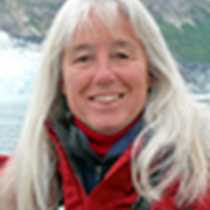Juneau/Stephens Passage
A visit to Alaska’s capitol city was on the agenda today. Juneau, with a population of about 30,000 people, has an excellent state museum and one of the most accessible glaciers in the world. Both were on the itinerary for Lindblad travelers this morning. En route, our coach driver-guides imparted a lot of information about the area. Gold was discovered here in 1880, precipitating one of many Alaskan booms and establishing the city that was to become Alaska’s third capitol. Now Juneau is the seat of government and a thriving and scenic summer tourist destination for cruise ships. Even this late in the season, four mega-ships were docked and their passengers were taking advantage of the end-of-season sales in the shops.
Juneau is on the edge of the mainland but daunting mountains and an imposing icefield block easy access from the east. The only way in is by plane, ship or birth canal. Because of this, all of Southeast Alaska remains relatively isolated and pristine, with a rich and productive flora and fauna.
The state museum has exhibits of native cultures around the state as well as mining history, natural history and a whimsical temporary exhibit about ravens. This cunning, charming and mysterious bird figures prominently in the legends and mythology of the Northwest Coast people, being at once a creator character and a trickster.
A short way out of town we arrived at the Mendenhall Glacier and had time to walk the trails and get good views of this beautiful (although receding) glacier, which spills out from the Juneau Icefield and into a lovely lake. It was exciting when a couple of black bears were spotted wandering in the area, interested in salmon that run up Steep Creek to spawn.
A few guests were lucky enough to get a perspective from the air, flying over the icefield and nearby glaciers.
In the afternoon there was free time for shopping and strolling on foot. A number of guests took the opportunity to ascend the tramway to the top of Mount Roberts.
The National Geographic Sea Bird pulled off the dock and turned south in the Gastineau Channel, continuing into Stephens Passage. National Geographic photographer, Flip Nicklin, made a presentation entitled “Whales – A Changing View”. He discoursed about the history of his career and how our ideas have evolved with underwater photography and new discoveries about a variety of marine mammals.
A visit to Alaska’s capitol city was on the agenda today. Juneau, with a population of about 30,000 people, has an excellent state museum and one of the most accessible glaciers in the world. Both were on the itinerary for Lindblad travelers this morning. En route, our coach driver-guides imparted a lot of information about the area. Gold was discovered here in 1880, precipitating one of many Alaskan booms and establishing the city that was to become Alaska’s third capitol. Now Juneau is the seat of government and a thriving and scenic summer tourist destination for cruise ships. Even this late in the season, four mega-ships were docked and their passengers were taking advantage of the end-of-season sales in the shops.
Juneau is on the edge of the mainland but daunting mountains and an imposing icefield block easy access from the east. The only way in is by plane, ship or birth canal. Because of this, all of Southeast Alaska remains relatively isolated and pristine, with a rich and productive flora and fauna.
The state museum has exhibits of native cultures around the state as well as mining history, natural history and a whimsical temporary exhibit about ravens. This cunning, charming and mysterious bird figures prominently in the legends and mythology of the Northwest Coast people, being at once a creator character and a trickster.
A short way out of town we arrived at the Mendenhall Glacier and had time to walk the trails and get good views of this beautiful (although receding) glacier, which spills out from the Juneau Icefield and into a lovely lake. It was exciting when a couple of black bears were spotted wandering in the area, interested in salmon that run up Steep Creek to spawn.
A few guests were lucky enough to get a perspective from the air, flying over the icefield and nearby glaciers.
In the afternoon there was free time for shopping and strolling on foot. A number of guests took the opportunity to ascend the tramway to the top of Mount Roberts.
The National Geographic Sea Bird pulled off the dock and turned south in the Gastineau Channel, continuing into Stephens Passage. National Geographic photographer, Flip Nicklin, made a presentation entitled “Whales – A Changing View”. He discoursed about the history of his career and how our ideas have evolved with underwater photography and new discoveries about a variety of marine mammals.



